When purchasing a budgie for the first time as a pet, it is important to know what a budgie eats at home and how its diet differs from natural conditions. In order for your pet to live long and not get sick, it is necessary to monitor its nutrition and diversify its diet with high-quality and healthy food.
What do parrots eat in the wild?
It is important to know what parrots and other small birds eat in their natural environment in order to provide them with everything they need at home. Wild budgerigars are nomadic birds that are found free-ranging in the arid regions of Australia.
They choose meadows and forested regions, and in rainy times they visit both farmland and suburbs. The regions where they live are very arid, so parrots may not drink water for a long time even in captivity.
In nature, small birds get:
- seeds of terrestrial plants, shrubs and trees;
- kangaroo grass seeds;
- bark of trees and shrubs;
- Exotic fruits.
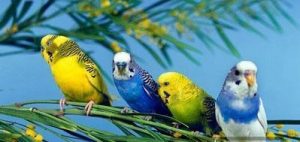
Birds fly from place to place, looking for food and sources of water. Their natural food depends on the region where budgerigars live in nature. As already mentioned, these are arid and semi-arid Australian regions, but the feeding there for small birds is very varied, nutritious and fortified.
Features of home feeding of a budgie
In addition to standard food at home, budgies need other sources of nutrients, microelements and vitamins necessary for healthy development and reproduction.
Watch the video of how a wavy eats from your hand
The issue of feeding is one of the most important for the owner. After all, the nutrition of parrots is the basis of their health and longevity, so you need to approach solving this problem with full responsibility.
This article will discuss in some detail the main components of the diet. If you teach your pet the right food from an early age, then in the future there will be no questions about what to feed the bird.
Grain feed is the basis of the diet
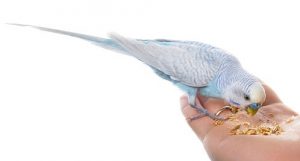
There is no need to invent anything here, but you should pay attention to ready-made food. Any pet store will help you choose the food that is right for your species. Ready-made grain mixtures from different manufacturers may differ slightly in composition, but in general, they all have approximately the same composition:
- – millet
- – oats
- – sunflower seeds (not roasted).
Some manufacturers also add vitamins to the feed. When purchasing food, you should pay attention to ensure that the packaging is intact and that the expiration date has not yet expired.
A young budgie at home and especially during seasonal molting should be fed not only with store-bought grain mixtures, but also with those prepared independently. Canaries, Corella parrots, and macaws also love them. Caring bird owners include seeds in such homemade mixtures:
- meadow grasses;
- flax;
- sunflower;
- sesame;
- hemp.
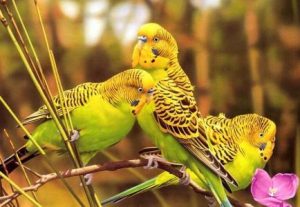
Birds should not eat roasted seeds. When feeding budgerigars and other small birds at home, the standard daily seed intake is 2 teaspoons per day.
Many birds eat only certain types of seeds, but they cannot be increased in the grain mixture.
Diluting the daily formula with different treats and additions can harm your pet.
Among owners of parrots (especially budgies), there is sometimes an opinion that grain food is quite enough for their birds. However, it is not.
Tree and bush branches for a healthy beak
The diet should not be limited to grains. It is no secret that all birds love to chew on something, and this “something” is not always useful for them (wallpaper, plaster, ceiling tiles, etc.). This is why many bird owners put tree branches in their cages.
It should be noted that branches should not be picked along highways, garbage dumps and factories – such wood is not safe for a budgie to eat.
It is best to go after them to the forest or the nearest park. Preference should be given to branches of birch, alder, chestnut, and willow. You should not let chewing on branches of coniferous trees (due to the tannins they contain) and poplar (due to their absorption of toxic substances from the atmosphere).
Poultry will not mind eating bark from the branches every day:
- 1) beech;
- 2) ash;
- 3) apple trees;
- 4) hazel;
- 5) raspberries;
- 6) aspen;
- 7) hawthorn;
- 8) viburnum.
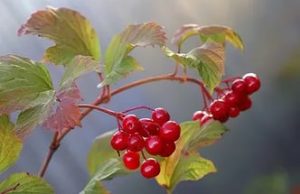
For variety, the pet is offered branches of citrus trees, chestnut, rowan, pear, and viburnum. For novice breeders who have not yet learned much about what parrots eat in the wild, it is worth knowing that they should not pick branches of acacia, elderberry, or lilac, which can poison poultry.
Before giving the branches to the bird, they must be soaked in cold water for several hours and then doused with boiling water.
Animal proteins in the bird’s diet
In addition to plant foods, about which much has already been said above, animal proteins can and should be added to the diet. Here, preference can be given to grated boiled egg or low-fat cottage cheese.
Animal proteins are very important in the home; The budgerigar happily eats most foods containing proteins. This is the main supplementary feed of animal origin, including a lot of vitamins and minerals that are absent in feed of plant origin.
Protein should be given to the bird daily during nesting, seasonal molting, and hatching small chicks; in other cases, once a week is sufficient.
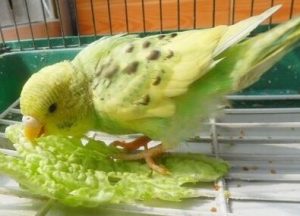
They provide such perishable food fresh daily and remove the remnants of the previous food, which quickly rots and can cause illness. Often separate feeders are prepared for animal food. The most common and harmless additives for animal protein are:
- 1. Boiled chicken egg. Parrots at home especially readily feed on yolk, which contains the highest concentration of vitamins and essential organic substances.
- The egg is also rich in minerals: iron, iodine, potassium, phosphorus, sulfur, chlorine, bromine. It is boiled for birds kept at home, hard-boiled and finely chopped.
-
- Budgerigar lovers prepare soft egg mixtures for their pets, adding white crackers, grated fresh beets, carrots, and semolina to the eggs. It is useful to add a couple of drops of fat to a tablespoon of protein food. As a rule, the wavy eats such food if it is accustomed to it right away.
- 2. Low-fat cottage cheese is a source of healthy protein, important for bird health. It includes magnesium and essential vitamins, as well as lactic acid, phosphorus, essential iron, and potassium. This product is given to the bird fresh and crumbly.
- Poisoning is caused by an acidified product. It is allowed to add semolina to cottage cheese.
- 3. Fish oil includes vitamins A and D, phosphorus necessary for the feathered friend and a rare element – iodine. A couple of drops of it are mixed into grain feed.
- 4. Gammarus or mealworms are a nutritious protein food for parrots. In the wild, wild birds rarely eat insects, but for proper home care it is necessary to include such components.
Mineral components and vitamins
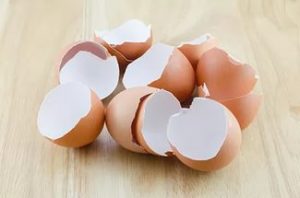
Mineral supplements are needed to provide the body with trace elements that are necessary for the formation of skeletal bones.
The cage must contain sepia (part of the cuttlefish skeleton), which is an excellent source of calcium. Bird chalk or pre-boiled and dried eggshells also work well.
For those who are just finding out what else a parrot eats at home, you should know about some more mineral supplements:
1. Bone meal. Together with egg shells, it is a source of phosphorus and calcium, which strengthens bones and feathers. Such additives are added to poultry sand or wet feed mixtures.
Flour is especially important during seasonal molting, because it nourishes the body of the wavy with salts, which are important in the formation of feathers. This simple and inexpensive feeding is sold in ordinary pet stores.
2. Small pebbles with sand. Under natural conditions, wild parrots eat such components along with other food. In the bird’s stomach, they mechanically grind food and aid in digestion and enzymatic breakdown.
Sand for birds is sold everywhere in sealed packs. It is prohibited to use plain sand from beaches or construction sites, as there is a risk of parasite infection.
3. Charcoal. In nature, budgies get it from the bark of trees. It contains important microelements.
It is ground and sprinkled onto the birds along with egg shells and sand. It removes heavy compounds, poisons and gases from the organs of a feathered friend.
What fruits and vegetables can parrots eat?
The diet of parrots should include fruits and vegetables – they are an important component of your feathered pet’s diet, as they contain vitamins and microelements.
The most useful for pets will be apples, plums, bananas, pears, strawberries, kiwi, pumpkin, corn, carrots or beets. You should not give your pet any spicy and pungent vegetables, as well as potatoes and eggplant (due to the solanine content they contain).
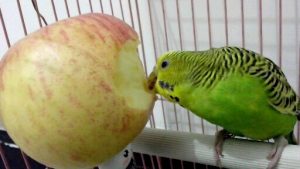
Every bird owner needs to know what else parrots eat besides food when keeping them at home. Their proper diet in nature includes exotic fruits, such as kiwi or all kinds of wild berries. It is better to add to the menu of wavy pet birds:
- Ӣsteamed or dried berries (lingonberries, blackberries, raspberries, blueberries, rowan, cranberries);
- Ӣ pomegranate;
- Ӣ citrus fruits;
- Ӣ cherries or sour cherries;
- Ӣ a pineapple;
- Ӣ green pea;
- Ӣ corn;
- Ӣ tomato;
- Ӣ green salad or spinach;
- Ӣ melon;
- Ӣ pumpkin;
- Ӣ different varieties of cabbage;
- Ӣ Bell pepper.
It is important to remember that all vegetables and fruits that you give to your bird must be fresh, thoroughly washed and free of any pesticides or other chemicals that could cause irreparable damage to your friend’s health.
Greenery will never harm parrots. For those who have not yet fully studied the question of what can be fed to pet budgies, it is worth knowing that such complementary foods will not harm the birds if administered daily. All grass should be well washed and fresh. Parrots love to eat:
- Ӣ burdock (burdock);
- Ӣ meadow grasses;
- Ӣ clover;
- Ӣ spinach leaves;
- Ӣ nettle;
- Ӣ grapevine;
- Ӣ green oats;
- Ӣ young leaves of fruit trees and cereals;
- Ӣ plantain leaves;
- Ӣ beet and carrot tops;
- Ӣ green leafy salads.
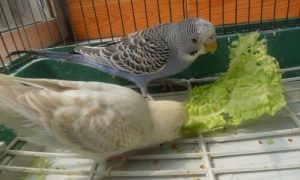
Dill, parsley, celery, cilantro and other fragrant and spicy herbs are prohibited for wavy plants. Lush greenery replenishes water reserves in nature. At home, the water is changed daily, without thinking about how long a parrot can normally live without water. Wild birds can withstand long intervals between fluid intakes, but in a home environment, fresh water should be given daily.
What is prohibited for pet parrots to eat?
It is forbidden to include fresh bread crumbs in the menu of small birds, only in the form of crushed crackers, as well as salt, milk, chocolate and other sweets, soups, fried foods, and flour products. This does not mean that the bird will refuse to eat this food, but it will lead to metabolic disorders, obesity and even premature death of the bird. Human food is not suitable for birds. Only a well-chosen menu guarantees the health of your wavy pet for many years.




